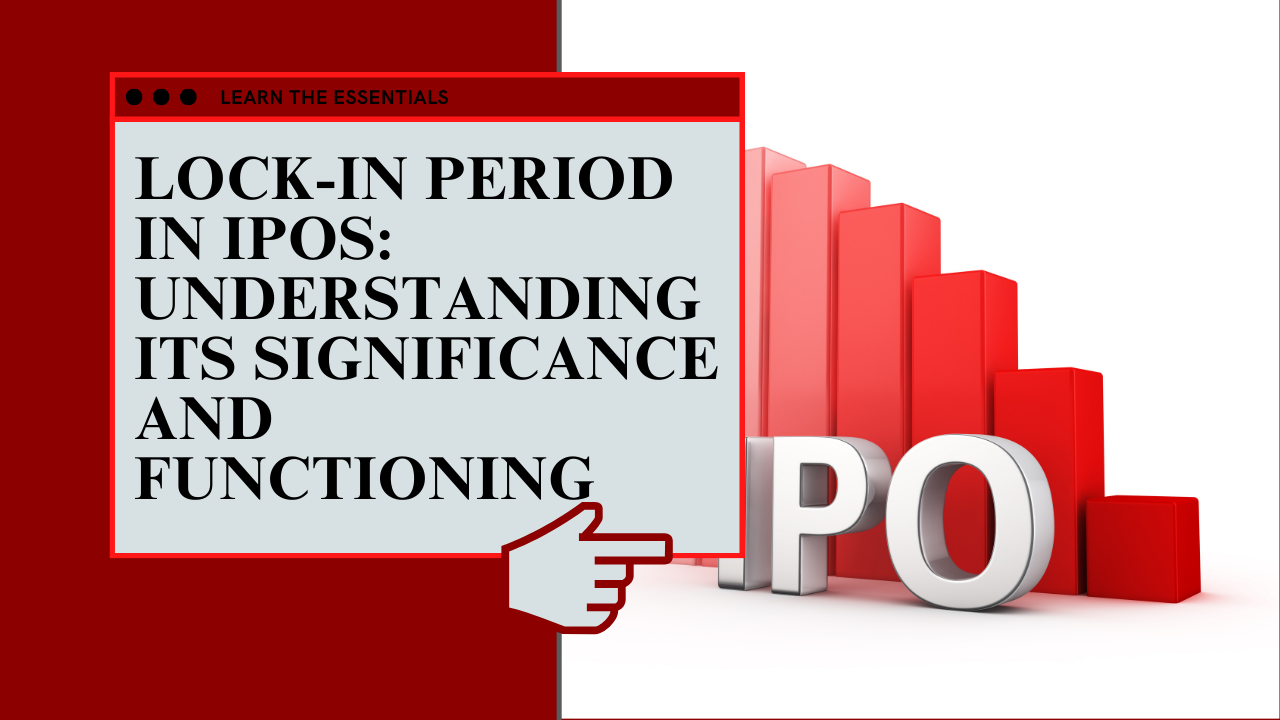The Lock-In Period in IPOs is an important mechanism that operates within the financial markets. Besides influencing investor behavior, this mechanism further affects the stability of stock prices after a firm has been floated on the stock exchange. This article talks about the nature of the lock-in period, explaining its importance, working, and implications on the parties involved.
What is a Lock-In Period in IPOs?
Lock-in period in IPOs refers to the predetermined period during which a group of shareholders like the company’s insiders, promoters, or pre-IPO investors cannot sell their shares in the open market. This time duration ranges from 90 days to 180 days as per the rules and regulations and the terms of agreement with the underwriters.

Why is the Lock-in Period in IPOs Important?
The lock-in period is very crucial for maintaining market stability after listing. Its importance can be drawn from the following:
1. Prevents Market Volatility
The lock-in period limits the selling of large portions of shares and thus ensures stability in the stock prices during the initial periods of trading.
2. Builds Investor Confidence
Retail investors are confident when they notice that insiders do not sell their shares, implying a long-term commitment to the firm.
3. Encourages Fair Valuation
A lock-in period minimizes speculative activities such that the stock will find a fair value depending on its performance or the company’s performance against demand in the market.
4. Lock-In Period in IPO
The lock-in period within the IPO is achieved through contractual law agreements, as well as regulatory aspects.
Here’s how this works:
1. Identifying the Restricted Shares
Shares which happen to belong to company insiders, such as those employees, early-stage investors and management individuals, are termed restricted shares
2. Designated Time Period
The lock-in period is agreed on prior to the launch of an IPO and varies with norms as dictated by regulations and underwriter negotiations.
3. Trading Restrictions
During the lock-in period, restricted shareholders cannot sell, transfer, or pledge their shares.
4. Lock-In Period Expiration
When the lock-in period elapses, the restricted shareholders can trade their shares freely; this usually results in a sharp increase in the trading volume.
5. Lock-In Period in IPO – Consequences
The lock-in period impacts various stakeholders of an IPO; these include companies, retail investors, and institutional participants.
Read More: Key Differences in How Companies Raise Capital: IPO vs FPO vs OFS
Companies
It fosters long-term shareholder confidence. The lock-in period is the most crucial element in the cultivation of long-term trust among shareholders. By requiring insiders and early investors to retain their holdings for a specified duration, the company signals a strong commitment to its growth and future prospects. This stability reassures investors that insiders have a vested interest in the company’s success, thereby fostering confidence in its long-term potential. It thus works to stabilize the lock-in period as an instrument to create a positive environment of sustainable shareholder relationships.

1. Avoids Price Manipulation Risks
The lock-in period minimizes the chances of market manipulation by limiting the selling activity of insiders. This keeps the stock price aligned with its intrinsic value, thereby ensuring that retail investors are saved from artificial price surges or declines.
2. Gives a Fair Idea About Insider Confidence
During the lock-in period, an insider cannot sell his shares, which indirectly expresses his confidence in the future growth prospects of the firm. For retail investors, it is a positive signal indicating that insiders believe in the long-term sustainability of the business.
Advantages to Institutional Investors
Institutional investors, who often lead the IPO market, enjoy several advantages through the lock-in period:

1. Judging the Firm’s Stability
The lock-in period gives the institutional investors a window to assess the stability of the company and its market performance before making large investments. It acts as a safeguard and allows them to analyze how the company fares in the public environment.
2. Opportunity for Strategic Investments
Once the lock-in period elapses, institutional investors can enter the market strategically. The end of the lock-in period usually means that trading increases, and therefore, there is a window to buy shares at prices that may be relatively attractive.
3.Investors’ Strategies Regarding the Lock-In Period in IPOs
To earn the highest possible returns while minimizing risks, investors can employ certain strategies specific to the lock-in period. Here’s how:
4. Keep Track of Insider Activity
When the lock-in period ends, the trading activity of insiders becomes a valuable indicator. If insiders start selling a significant portion of their holdings, it might signal doubts about the company’s future. Conversely, if they retain their shares, it could reflect confidence in the business’s growth trajectory.
5. Analyze Stock Volatility
Lock-in ends typically see a spurt in volume trades. Thus, the prices often remain highly volatile for some short-term period. Shrewd investors can sense the pattern of such price movement and get ready for this particular play, taking the temporary downswings and then making long-term investment at a stabilization point.
6. Long-term Perspective
In addition to the direct implications of a lock-in period, an investor will instead find the fundamentals of a firm. This may range from the financial health to a strategic growth and also where in the industry stands such firm. A long term provides an investment which does not base its judgment upon current market fluctuations.
7. Lock-in period in IPO
Regulating authorities view a lock-in period as being used towards maintaining market integrity. In India, for example, SEBI has set a minimum lock-in period for company promoters. It means that promoters retain a large equity stake in the company for a specified time post-IPO. Regulations such as these prevent a quick sell-off and instead encourage ethical practices in equity markets. By aligning insider and public investor interests, regulatory frameworks ensure a level playing field, fostering trust and transparency in the market.
Conclusion
The lock-in period in public offerings, therefore, acts like a stabilizing force on the dynamic world of public offerings: it keeps sudden sell-offs to a minimum, fosters investor confidence, and upholds market equilibrium, thus achieving a level playing field for all participants in the market.
Understanding the lock-in period is crucial for retail investors and companies alike to make informed decisions. The lock-in period in IPOs remains a cornerstone of sustainable and transparent equity trading as the financial markets continue to evolve.

